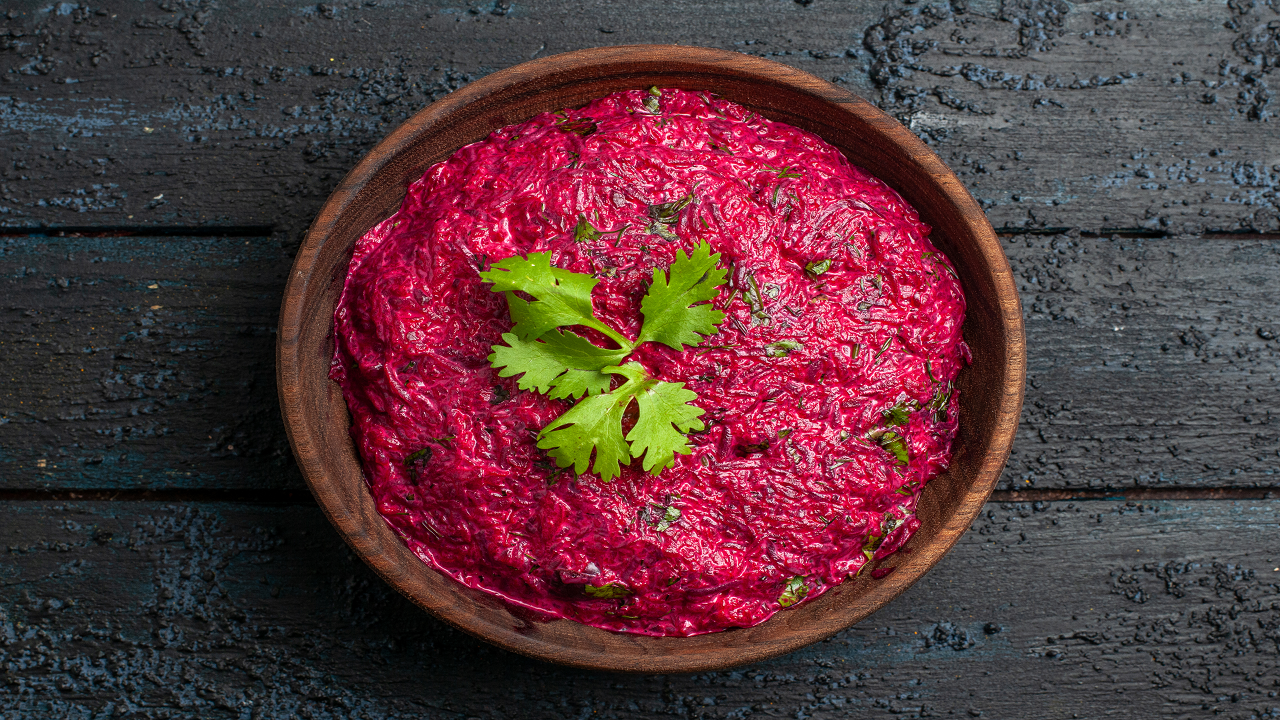
Beetroot pachadi, a vibrant and flavorful South Indian dish, is a delightful medley of flavors and textures that graces the table during festive occasions and everyday meals alike. Pachadi, a term used to describe a type of side dish in the South Indian culinary lexicon, typically features a balance of sweet, sour, and spicy elements.
In this particular dish, earthy beetroot takes center stage, lending its natural sweetness and striking hue to the preparation. The beetroot is cooked until tender, finely grated, and then blended with creamy yogurt, aromatic spices, and a tadka (tempering) of mustard seeds and curry leaves. The resulting pachadi boasts a harmonious combination of tastes, making it a favourite accompaniment to rice, roti, and other main dishes. With its visually appealing presentation and delectable flavor profile, beetroot pachadi continues to captivate both the eyes and palates of those who have the pleasure of savoring it.
Basic Beetroot Pachadi Recipe
Ingredients To Cook Beetroot Pachadi or beetroot kachadi:
- 1 medium-sized beetroot, peeled and grated
- 1 cup plain yogurt (curd)
- Salt to taste
- Water for boiling
- 1 tablespoon oil (preferably coconut oil)
- 1/2 teaspoon mustard seeds
- 1/2 teaspoon cumin seeds
- 2-3 dry red chilies
- A pinch of asafoetida (hing)
- 1 sprig curry leaves
- 2 tablespoons grated coconut (optional)
- 1-2 green chilies, chopped (adjust to taste)
- Coriander leaves for garnishing
Instructions to Cook Beetroot Pachadi:
1. Boil the Beetroot:
- In a pot, add enough water to cover the grated beetroot.
- Add a pinch of salt and boil the grated beetroot until it becomes tender. This usually takes about 5-7 minutes.
- Once the beetroot is cooked, drain the water and set the beetroot aside.
2. Prepare the Yogurt Mixture:
- In a mixing bowl, whisk the yogurt until it becomes smooth.
- Add the cooked beetroot to the yogurt and mix well.
- If using grated coconut, you can add it to the yogurt mixture at this stage.
3. Prepare the Seasoning:
- Heat oil in a small pan over medium heat.
- Add mustard seeds and let them splutter.
- Add cumin seeds, dry red chilies, and curry leaves. Sauté for a few seconds until fragrant.
- Add a pinch of asafoetida (hing) and chopped green chilies. Sauté for another few seconds.
4. Combine Everything:
- Pour the seasoning mixture over the beetroot-yogurt mixture and mix well.
- Add salt to taste and adjust the seasoning if necessary.
5. Garnish and Serve:
- Garnish the Beetroot Pachadi with chopped coriander leaves.
- Serve the pachadi as a side dish with steamed rice or any South Indian meal.
Benefits of Eating Beetroot Pachadi
Beetroot Pachadi not only offers a burst of flavors but also provides several potential health benefits due to its main ingredient, beetroot. Here are some of the benefits of eating beetroot pachadi:
Nutrient-Rich: Beetroot is a good source of essential nutrients, including vitamins (like vitamin C, folate), minerals (such as potassium, magnesium), and dietary fiber.
Antioxidant Properties: Beetroot is rich in antioxidants, particularly betalains and anthocyanins, which can help combat oxidative stress and reduce the risk of chronic diseases.
Heart Health: The nitrates present in beetroot can help dilate blood vessels, improve blood flow, and lower blood pressure, contributing to overall heart health.
Digestive Health: The dietary fiber in beetroot can promote healthy digestion and regular bowel movements, supporting gut health.
Anti-Inflammatory: Some compounds in beetroot, including betalains, exhibit anti-inflammatory properties that can help reduce inflammation in the body.
Potential Exercise Benefits: Beetroot's nitrates have been shown to enhance exercise performance by improving oxygen utilization and increasing endurance.
Supports Detoxification: Beetroot contains compounds that support the body's natural detoxification processes, particularly the liver.
Brain Health: Nitrates in beetroot may improve blood flow to the brain, potentially enhancing cognitive function and reducing the risk of cognitive decline.
Weight Management: The fiber content in beetroot can help promote feelings of fullness and reduce overeating, which can be beneficial for weight management.
Skin Health: The antioxidants and nutrients in beetroot can contribute to healthy skin by promoting collagen production and protecting against oxidative damage.
Cancer Prevention: Some studies suggest that the phytonutrients in beetroot may have anti-cancer properties, although further research is needed.
Blood Sugar Regulation: The fiber and nutrients in beetroot can contribute to stable blood sugar levels when consumed as part of a balanced diet.
Beetroot Pachadi In Malayalam And Other Regions
Beetroot pachadi which is also known as Beetroot Kichadi is a traditional South Indian dish that is popular in various regions of South India, particularly in states like Kerala, Tamil Nadu, and Andhra Pradesh. It is commonly prepared and enjoyed in households and during festivals, weddings, and special occasions in these regions. Each state might have its own variations in terms of the spices used or the method of preparation, but the basic concept of combining beetroot with yogurt and spices remains consistent.
In Kerala, beetroot pachadi is often a part of the traditional Onam Sadhya, a grand vegetarian feast served during the festival of Onam. It's also enjoyed in everyday meals as a side dish.
In Tamil Nadu, beetroot pachadi might be called "beetroot thayir pachadi," emphasizing the use of yogurt in the dish. It is often served alongside rice and other traditional Tamil dishes.
Andhra Pradesh, known for its spicier cuisine, might add a bit more heat to the pachadi with the inclusion of green chilies or red chili powder.
While these are the primary regions where beetroot pachadi is popular, its appeal has extended beyond these areas due to the ease of sharing recipes and cultural influences. As a result, you might find variations or adaptations of beetroot pachadi in other parts of India and even among the global Indian diaspora.

















